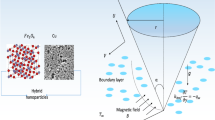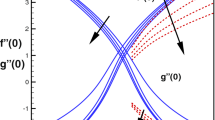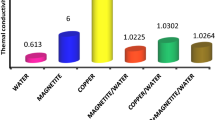Abstract
The main emphasis of the current work is to study a proficient nanofluid model. Thermal conductivity of nanofluid is estimated via KKL (Koo–Kleinstreuer–Li) model keeping the nanoparticles influence up to 0.6%. Further, inclined magnetic field, viscous forces and Cattaneo–Christov effects are included in the analysis. The obtained KKL-nanofluid model is studied via LSM over the domain. From the model outcomes, it is examined that dynamic viscosity, density and heat capacity of the functional liquid enhanced from 1.0025 to 1.01516, 1.00706 to 1.04237 and 1.00106 to 1.00638, by taking the Al2O3 amount from 0.15 to 0.6%, respectively. Keeping the inclined Lorentz forces strength from 1.0 to 4.0 leads to drops in the fluid gesture in the lower half of the domain. Implication of magnetic field from various angles (\(\gamma ={35}{^\circ }, {45}{^\circ }, {55}{^\circ }, {65}{^\circ })\) highly resists the movement. Moreover, inclusion of \({\alpha }_{1}=\mathrm{0.1,0.2,0.3,0.4}\), \({\alpha }_{2}=\mathrm{0.2,0.4,0.6,0.8}\), \({E}_{\mathrm{c}1}=\mathrm{0.1,0.2,0.3,0.4}\) and nanoparticles amount \(\phi =\mathrm{0.02,0.04,0.06,0.08}\) positively enhanced the working fluid temperature and the fluid molecules gained much temperature when the plate accelerated outward from the lower once. For the particular setup, the radiative flux and Lorentz forces in the existence of CCM controlled the fluid temperature. Thus, the temperature performance of the fluid diminished when the magnetic field acted through increasing angle.











Similar content being viewed by others
Abbreviations
- \({\check{u}}, {\check{v}}\) :
-
Velocity components along the coordinates (m/s)
- \({\check{p}}\) :
-
Pressure (Pa)
- \({\check{T}}\) :
-
Temperature (K)
- \({\check{u}}_\text{nf}\) :
-
Improved dynamic viscosity (kg/m s)
- \({\check{u}}_\text{f}\) :
-
Base liquid dynamic viscosity (kg/m s)
- \({\rho }_{\mathrm{nf}}\) :
-
Improved density of nanoliquid (kg/m3)
- \({\rho }_{\mathrm{f}}\) :
-
Density of base liquid (kg/m3)
- \({\check{\sigma}}_\text{nf}\) :
-
Improved electrical conductivity (S/m)
- \({k}_{\mathrm{nf}}\) :
-
Enhanced thermal conductivity (W/mK)
- \({\left({c}_{\mathrm{p}}\right)}_{\mathrm{nf}}\) :
-
Enhanced heat capacity (J/K)
- \(\eta\) :
-
Similarity variable
- \(F\) :
-
Dimensionless velocity
- \(\beta\) :
-
Dimensionless temperature
- \(M\) :
-
Hartman number
- \({P}_{\mathrm{r}}\) :
-
Prandtl number
- \({E}_{\mathrm{c}1}\) :
-
Eckert number
- \({R}_{\mathrm{d}}\) :
-
Radiation number
- \(\phi\) :
-
Nanoparticles concentration
- \({\alpha }_{1}\) :
-
Thermal relaxation number
References
Gowda RJP, Kumar RN, Jyothi AM, Prasannakumara BC, Nisar KS. KKL correlation for simulation of nanofluid flow over a stretching sheet considering magnetic dipole and chemical reaction. J Appl Math Mech. 2021. https://doi.org/10.1002/zamm.202000372.
Alsagri S, Moradi R. Application of KKL model of studying of nanofluid heat transfer between two rotary tubes. Case Stud Therm Eng. 2019. https://doi.org/10.1016/j.csite.2019.100478.
Sheikholeslami M, Rashidi M, Saad A, Firouzi F, Rokni B, Domairry G. Steady nanofluid flow between parallel plates considering the thermophoresis and Browanian effects. J King Saud Univ Sci. 2016. https://doi.org/10.1016/j.jksus.2015.06.003.
Adnan, Ashraf W. Thermal efficiency in hybrid (Al2O3-CuO/H2O) and ternary hybrid nanofluids (Al2O3-CuO-Cu/H2O) by considering the novel effects of imposed magnetic field and convective heat condition. Waves Random Complex Media. 2022. https://doi.org/10.1080/17455030.2022.2092233.
Sharma BK, Gandhi R, Abbas T, Bhatti MM. Magnetohydrodynamics hemodynamics hybrid nanofluid flow through inclined stenotic artery. Appl Math Mech. 2023;44:459–76.
Adnan, Ashraf W. Heat transfer mechanism in ternary nanofluid between parallel plates channel using modified Hamilton–Crossers model and thermal radiation effects. Geoenergy Sci Eng. 2023. https://doi.org/10.1016/j.geoen.2023.211732.
Wang F, Kumar RSV, Sowmya G, El-Zahar ER, Prasannakumara BC, Khan MI, Khan SU, Malik MY, Xia WF. LSM and DTM-Pade approximation for the combined impacts of convective and radiative heat transfer on an inclined porous longitudinal fin. Case Stud Therm Eng. 2022. https://doi.org/10.1016/j.csite.2022.101846.
Alhejaili W, Kumar RSV, El-Zahar ER, Sowmya G, Prasannakumara BC, Khan MI, Yogeesha KM, Qayyum S. Analytical solution for temperature equation of a fin problem with variable temperature-dependent thermal properties: application of LSM and DTM-Pade approximant. Chem Phys Lett. 2022. https://doi.org/10.1016/j.cplett.2022.139409.
Kumar RN, Gowda RJP, Madhukesh JK, Prasannakumara BC, Ramesh GK. Impact of thermophoretic particle deposition on heat and mass transfer across the dynamics of Casson fluid flow over a moving thin needle. Phys Scr. 2021. https://doi.org/10.1088/1402-4896/abf802.
Mabood F, Rauf A, Prasannakumara BC, Izadi M, Shehzad SA. Impacts of Stefan blowing and mass convention on flow of Maxwell nanofluid of variable thermal conductivity about a rotating disk. Chin J Phys. 2021;71:260–72.
Rekha MB, Sarris IE, Madhukesh JK, Raghunatha KR, Prasannakumara BC. Activation energy impact on flow of AA7072-AA7075/water-based hybrid nanofluid through a cone, wedge and plate. Micromachines. 2022. https://doi.org/10.3390/mi13020302.
Mahmoodi M, Kandelousi S. Semi-analytical investigation of kerosene alumina nanofluid between two parallel plate. J Aerosp Eng. 2016. https://doi.org/10.1061/(ASCE)AS.1943-5525.0000590.
Rizk D, Ullah A, Ikramullah ES, Alharbi M, Sohail M, Khan R, Khan A, Mlaiki N. Impact of the KKL correlation model on the activation of thermal energy for the hybrid nanofluid flow through permeable vertically rotating surface. Energies. 2022. https://doi.org/10.3390/en15082872.
Ali B, Mishra NK, Rafique K, Jubair S, Mahmood Z, Eldin SM. Mixed convective flow of hybrid nanofluid over a heated stretching disk with zero-mass flux using the modified Buongiorno model. Alex Eng J. 2023;72:89–96.
Ganji D, Hatami M. Squeezing cu-water nanofluid flow analysis between parallel plates by DTM-Pade Method. J Mol Liq. 2014. https://doi.org/10.1016/j.molliq.2013.12.034.
Adnan. Heat transfer inspection in [(ZnO-MWCNTs)/water-EG(50:50)]hnf with thermal radiation ray and convective condition over a Riga surface. Waves Random Complex Med. 2022. https://doi.org/10.1080/17455030.2022.2119300.
Alharbi KAM, Galal AM. Novel magneto-radiative thermal featuring in SWCNT–MWCNT/C2H6O2–H2O under hydrogen bonding. Int J Mod Phys B. 2023. https://doi.org/10.1142/S0217979224500176.
Abbas N, Shatanawi W, Shatnawi M. Transportation of nanomaterial Maxwell fluid flow with thermal slip under the effect of soret-Dufour and second-order slips: nonlinear stretching. Sci Rep. 2023. https://doi.org/10.1038/s41598-022-25600-9.
Rana S, Nawaz M. Investigation of enhancement of heat transfer in sutterby nanofluid using Koo–Klienstreuer and Li correlations and Cattaneo–Christov heat flux model. Phys Scr. 2019. https://doi.org/10.1088/1402-4896/ab23af.
Mishra NK, Khalid AMA, Rahman KU, Adnan, Eldin SM, Fwaz MZB. Investigation of improved heat transport featuring in dissipative ternary nanofluid over a stretched wavy cylinder under thermal slip. Case Stud Therm Eng. 2023. https://doi.org/10.1016/j.csite.2023.103130.
Al-Zahrani AA, Adnan, Mahmood I, Khaleeq RU, Mutasem ZBF, Tag-Eldin E. Analytical study of (Ag–graphene)/blood hybrid nanofluid influenced by (platelets-cylindrical)nanoparticles and Joule heating via VIM. ACS Omega. 2023;8:19926–38.
Alizadeh A, Takami S, Iranmanesh R, Pasha P. Evaluation of AGM and FEM method for thermal radiation on nanofluid flow between two tubes in nearness of magnetism field. Heliyon. 2023. https://doi.org/10.1016/j.heliyon.2023.e16788.
Sotehi N, Kezzar M, Tabet I, Sari R. Natural convection flow and heat transfer of nanofluid in porous media for diffrent shapes and nanoparticles using analytical and numerical methods. Spec Top Rev Porous Med Int J. 2021. https://doi.org/10.1615/specialTopicsRevporousMedia.2021030463.
Bilal A, Sidra J, Al-Essa LA, Zafar M, Al-Bossly A, Alduais FS. Boundary layer and heat transfer analysis of mixed convective nanofluid flow capturing the aspects of nanoparticles over a needle. Mater Today Commun. 2023. https://doi.org/10.1016/j.mtcomm.2023.106253.
Geridonmez B. Numerical investigation of ferrofluid convection with Kelvin forces and non-Darcy effects. AIMS Math. 2018;3:195–210.
Feng. Thermal nanofluid property model with application to nanofluid flow in a parallel-disk syestem-part I: a new thermal conductivity Model for nanofluid Flow. ASME J Heat Mass Transf. 2012. https://doi.org/10.1115/1.4005632.
Abbas W, Adnan, Sayed ME, Mutasem ZBF. Numerical investigation of non-transient comparative heat transport mechanism in ternary nanofluid under various physical constraints. AIMS Math. 2023;8:15932–49.
Abdulkhaliq KAM, Adnan, Akgul A. Investigation of Williamson nanofluid in a convectively heated peristaltic channel and magnetic field via method of moments. AIP Adv. 2023. https://doi.org/10.1063/5.0141498.
Khan Z, Haq U, Ali F, Andualem M. Free convection flow of second grade dusty fluid between two parallel plates using Fick’s and Fourier’s laws: a fractional model. Sci Rep. 2022. https://doi.org/10.1038/s41598-022-06153-3.
Pattanaik C, Mishra R, Jena S. Impact of dissipative heat energy on the conducting Jeffery-Hamel KKL based nanofluid model: a numerical approach. Res Sq. 2022. https://doi.org/10.21203/rs.3.rs-1947801/v1.
Ali B, Jubair S, Fathima D, Akhter A, Rafique K, Mahmood Z. MHD flow of nanofluid over moving slender needle with nanoparticles aggregation and viscous dissipation effects. Sci Prog. 2023. https://doi.org/10.1177/00368504231176151.
Razzaq A, Raza N. Heat and mass transfer analysis of Brinkman type fractional nanofluid over a vertical porous plate with velocity slip and Newtonian heating. J Math. 2019;2019:45–69.
Adnan, Ashraf W. Heat transfer in tetra-nanofluid between converging/diverging channel under the influence of thermal radiations by using Galerkin finite element method. Waves Random Complex Med. 2023. https://doi.org/10.1080/17455030.2023.2171154.
Adnan, Waqas A. Joule heating and heat generation/absorption effects on the heat transfer mechanism in ternary nanofluid containing different shape factors in stretchable converging/diverging Channel. Waves Random Complex Med. 2023. https://doi.org/10.1080/17455030.2023.2198038.
Khadija R, Mahmood Z, Alqahtani H, Sayed ME. Various nanoparticle shapes and quadratic velocity impacts on entropy generation and MHD flow over a stretching sheet with joule heating. Alex Eng J. 2023;71:147–59.
Li Z, Khan I, Shafee A, Tlili I, Asifa T. Energy transfer of Jeffery-Hamel nanofluid flow between non-parallel walls using Maxwell-Garnetts and Brinkman models. Energy Rep. 2018. https://doi.org/10.1016/j.egyr.2018.05.003.
Adnan, Alharbi KAM, Bani-Fwaz MZ, Eldin SM, Yassen MF. Numerical heat performance of TiO2/Glycerin under nanoparticles aggregation and nonlinear radiative heat flux in dilating/squeezing channel. Case Stud Therm Eng. 2023. https://doi.org/10.1016/j.csite.2022.102568.
Nadeem A, Sayed ME. Heat transport mechanism in glycerin-titania nanofluid over a permeable slanted surface by considering nanoparticles aggregation and Cattaneo Christov thermal flux. Sci Prog. 2023. https://doi.org/10.1177/00368504231180032.
Jha K, Aina B, Ajiya T. MHD naural convection flow in a vertical parallel plate microchannel. Ain Shams Eng J. 2015;6:289–95.
Bhatti M. Recent trends in nanofluid. Inventions. 2021. https://doi.org/10.3390/inventions6020039.
Muhammad N, Nadeem S, Mustafa T. Squeezed flow of a nanofluid with Cattaneo-Christov heat and mass fluxes. Results Phys. 2017;7:862–9.
Ahmed N, Adnan, Khan U, Mohyud-Din ST, Manzoor R. Influence of viscous dissipation on a copper oxide nanofluid in an oblique channel: Implementation of the KKL model. Eur Phys J Plus. 2017. https://doi.org/10.1140/epjp/i2017-11504-y.
Bhatti MM, Sait SM, Ellahi R, Sheremet MA, Oztop H. Thermal analysis and entropy generation of magnetic Eyring-Powell nanofluid with viscous dissipation in a wavy asymmetric channel. Int J Numer Meth Heat Fluid Flow. 2022;33:1609–36.
Aich W, Adnan, Almujibah H, Abdullaev SS, Bani-Fwaz MZ, Hassan AM. Thermal performance of radiated annular extended surface using advanced nanomaterials influenced by various physical controlling parameters for nucleate boiling case. Case Stud Therm Eng. 2023. https://doi.org/10.1016/j.csite.2023.103524.
Zhang L, Tariq N, Bhatti MM. Study of nonlinear quadratic convection on magnetized viscous fluid flow over a non-Darcian circular elastic surface via spectral approach. J Taibah Univ Sci. 2023. https://doi.org/10.1080/16583655.2023.2183702.
Rashidi MM, Mahariq I, Nazari MA, Accouche O, Bhatti MM. Comprehensive review on exergy analysis of shell and tube heat exchangers. J Therm Anal Calorim. 2022;147:12301–11.
Nidhish KM, Adnan, Sarfraz G, Fwaz MZB, Eldin SM. Dynamics of Corcione nanoliquid on a convectively radiated surface using Al2O3 nanoparticles. J Therm Anal Calorim. 2023. https://doi.org/10.1007/s10973-023-12448-y.
Adnan, Waqas A. Analysis of heat transfer performance for ternary nanofluid flow in radiated channel under different physical parameters using GFEM. J Taiwan Inst Chem Eng. 2023. https://doi.org/10.1016/j.jtice.2023.104887.
Riaz M, Khan N, Hashmi MS, Alshomrani AS, Inc M. Darcy Forchheimer flow of chemically reactive magnetized ZnO-SAE50 nanolubricant over Riga plate with thermophoretic particle deposition: a numerical approach. J Therm Anal Calorim. 2023. https://doi.org/10.1007/s10973-023-12468-8.
Mohanty D, Mahanta G, Shaw S, Sibanda S. Thermal and irreversibility analysis on Cattaneo-Christov heat flux-based unsteady hybrid nanofluid flow over a spinning sphere with interfacial nanolayer mechanism. J Therm Anal Calorim. 2023. https://doi.org/10.1007/s10973-023-12464-y.
Acknowledgements
The authors extend their appreciation to the Deanship of Scientific Research at King Khalid University for funding this work through large group Research Project under Grant Number RGP. 2/7/44.
Author information
Authors and Affiliations
Corresponding author
Ethics declarations
Conflict of interest
There is no competing interest regarding the publication of this work.
Additional information
Publisher's Note
Springer Nature remains neutral with regard to jurisdictional claims in published maps and institutional affiliations.
Rights and permissions
Springer Nature or its licensor (e.g. a society or other partner) holds exclusive rights to this article under a publishing agreement with the author(s) or other rightsholder(s); author self-archiving of the accepted manuscript version of this article is solely governed by the terms of such publishing agreement and applicable law.
About this article
Cite this article
Adnan, Nadeem, A. & Said, N.M. LSM analysis of thermal enhancement in KKL model-based unsteady nanofluid problem using CCM and slanted magnetic field effects. J Therm Anal Calorim 149, 839–851 (2024). https://doi.org/10.1007/s10973-023-12801-1
Received:
Accepted:
Published:
Issue Date:
DOI: https://doi.org/10.1007/s10973-023-12801-1




